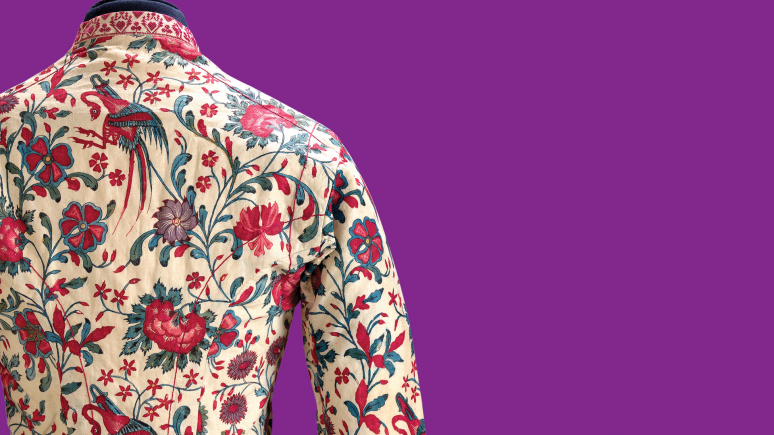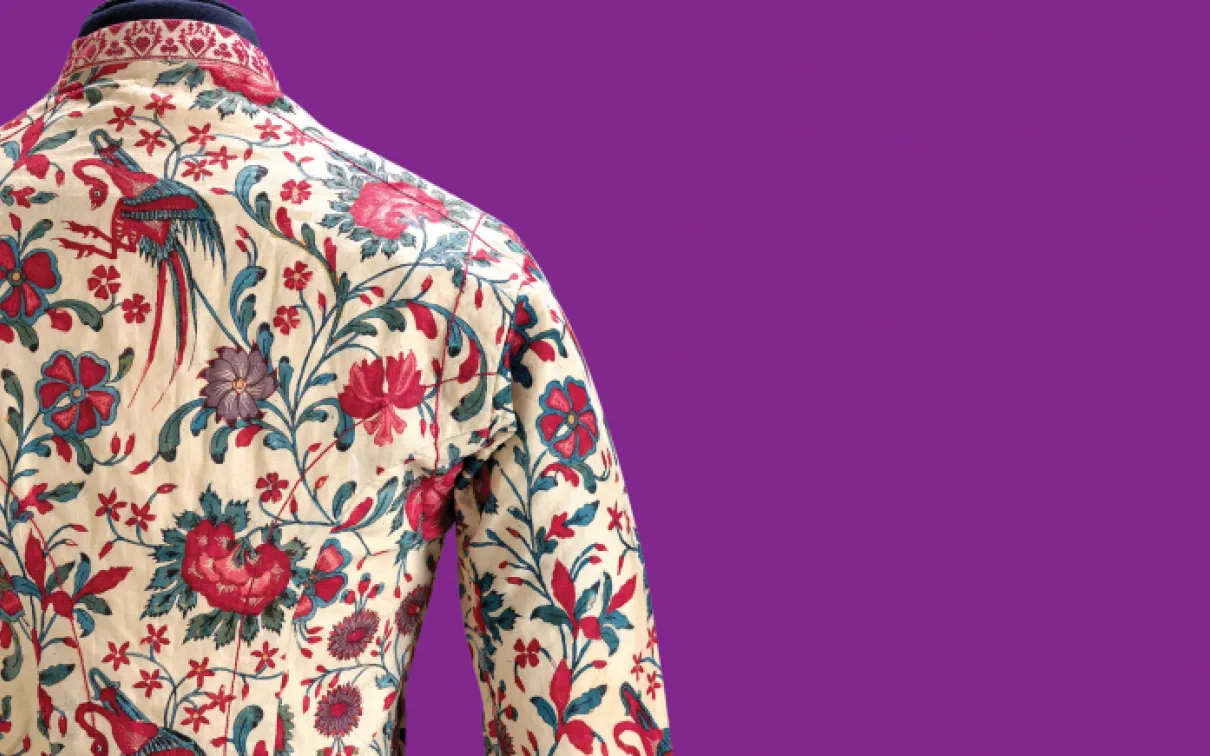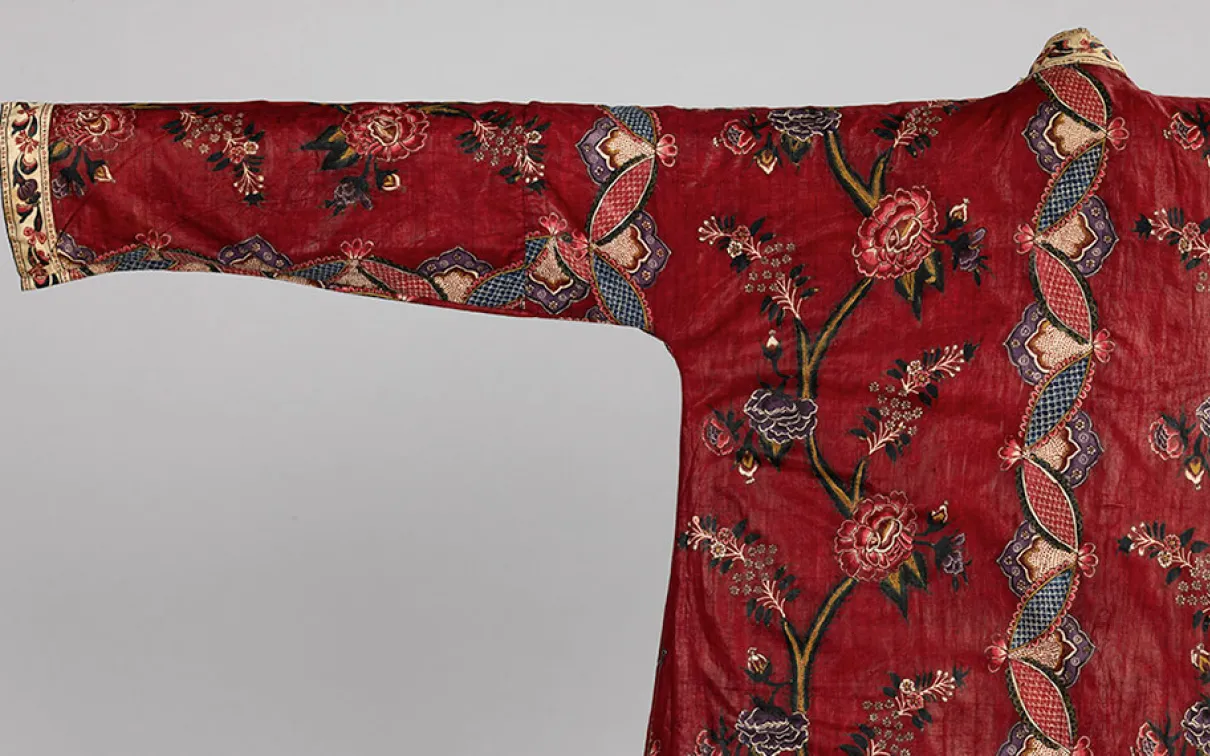The Global Craze for Cotton and Colour
How Indian chintz transformed fashion, trade, and technology.
Of all the remarkable textile
Of all the remarkable textile traditions that India has bestowed on the world, its printed and painted cotton textiles, popularly known as chintz, have arguably had the longest and greatest global impact. Over the millennia, these vibrantly coloured and boldly patterned cottons have been coveted as fashionable dress and luxury furnishings, as gifts and sacred objects, both throughout the Indian subcontinent and around the world. The desire first to possess and then later to imitate Indian chintz transformed the arts, industries, and economies on five continents, with reverberations still felt today.
The Art of Painting and Printing Cottons
Readers today might associate the word “chintz” with old-fashioned floral printed cottons factory made in Britain, or a product of inferior quality—“chintzy.” But such associations are many steps and many centuries removed from the remarkable original chintz handmade in India.
From ancient times, the great Indian subcontinent clothed itself, and much of the world, with its cotton cloth. The majority was plain or patterned with stripes or checks, some ornamented by brocading or embroidery. A very different embellishment was created by specialized artisans who used cotton fabric as a sort of canvas; upon it, they drew or printed special substances which, once combined with vegetable dyes, produced bold designs in vibrant colours that did not fade. Europeans came to refer to these exquisitely patterned textiles as chintz.
Using these methods, Indian artisans created an incredible range of compositions, from tiny repeating floral blossoms to monumental scenes of royal elephant fights.
Appreciating the art—and genius—of Indian chintz thus begins with appreciating the sophisticated techniques and colour chemistry developed by the subcontinent’s artisans. Certain natural features predisposed South Asia to create these brilliant works: unique climatic conditions that favour the cultivation of cotton and potent subtropical dye plants, as well as waters with special mineral properties that improved colour. Production centres historically were located along rivers and widely spread; the regions of Sind, Gujarat, Rajasthan, and the southeastern coastline (formerly known as the Coromandel Coast) are associated with the greatest production. But the key ingredient was human ingenuity to domesticate cotton, develop remarkably complex chemical processes, perfect unrivalled hand skills, and create sophisticated supply chains.
An essential element of Indian chintz is its cotton cloth base, and India’s mastery of cotton dates back at least 5,000 years. Archaeological evidence links the domestication of one species, the so-called tree cotton (Gossypium arboreum), to the rise of the great Indus Valley civilization that flourished from 3500 to 2000 BCE in the area bridging today’s India and Pakistan.
Although cotton cultivation and weaving spread out from India as early as 500 BCE, India nevertheless remained the world’s largest cotton cloth producer. This abiding dominance can be traced in large part to the subcontinent’s incomparable mastery of colour. It is exceedingly difficult to infuse cotton fibre with brilliant and durable colour using natural dyes; yet craftsmen in the subcontinent developed and perfected recipes for a multitude of colours, both lightfast and washfast.
The Global Desire for Indian Chintz
India was likely exporting cotton textiles as early as 3000 BCE. Certainly by medieval times, Indian cottons were traded across the breadth of the Indian Ocean from Northeast Africa to Southeast Asia.
The earliest surviving examples—found at Red Sea ports and dated as early as the 10th century—reveal the deep and durable colours and intricate patterns that made them so popular. Much Indian chintz flowed to Indonesian islands, where local traders demanded it in exchange for the precious spices that Indonesia alone produced at the time—cloves, mace, nutmeg. In search of these spices, from 1498 the Portuguese sailed directly to India around the tip of southern Africa, opening new maritime routes. State-sponsored trading companies from the Netherlands, Britain, Denmark, and France followed after 1600.
Europe’s own desire for Indian chintz sowed the seeds—imperceptible at first—for disruptions in the longstanding rhythms of global production and trade. Europeans found themselves obliged to acquire Indian textiles to barter for Indonesia’s spices. Thus, they established their first trading posts (“factories”) near India’s great textile production areas—Gujarat, Bengal, and the southeast coast—locating and relocating their settlements in the last area especially to source Indian chintz.
In the 17th century, Europe’s East India trading companies discovered profits could be made by trading Indian chintz to Europe itself. Sometimes referred to as a “calico craze,” European chintz dress fashions developed slowly.
At first, European elites delighted in large Indian chintz furnishing fabrics—carpets, wall covers, bed curtains—painted with exotic florals and scenes. But soon, the colourful, washable fabric was embraced as fashionable dress across many classes. Cheaper than silk, Indian chintz brought coloured pattern to many social strata and is recognized as the first mass fashion.
At the trade’s peak in the 1680s
At the trade’s peak in the 1680s, the British East India Company was annually importing one million pieces of Indian cottons to Europe, with French cargoes consisting of 57% Indian chintz. Europe’s own cloth manufacturers of silk, linen, and wool did not celebrate this imported newcomer. They rose up in protest and even rioted against the foreign cottons. Governments in France and England implemented a series of bans from 1686 to 1774 forbidding imports or dressing in Indian chintz. But threats of fines, imprisonment, or even death did not stop smugglers from importing the cloth, or women from brazenly wearing it.
In response, European trading companies increased trafficking the cloth to Africa, the Pacific, and the Americas—from Canada to Brazil—where it was eagerly sought by Indigenous and settler communities. Although each market developed precise tastes and changing fashions in florals and ground colours, the net result was that Indian chintz had become a truly global fashion. An iniquitous four-stop trade arose: Europeans carried Indian cottons to West Africa, which they traded for enslaved captives, whom they took to the Americas to cultivate transplanted crops—sugar and, later, indigo and cotton—for consumption in Europe; the proceeds were then taken to India for the purchase of textiles and other goods. At the same time, West Asia and Southeast Asia continued to consume enormous quantities of India’s painted and printed cottons.
The Consequences of Global Desire
Struggling to supply escalating global demand for Indian chintz, Europeans adopted strategies that reshaped the world. They attempted to force sales of cloth and monopolize Indian weavers and painters, or relocate them to European trading forts. Ultimately, the British East India Company, backed by extraordinary powers and its own army, colonized India’s major textile-producing areas. A concurrent movement had even more wide-reaching effects: imitating the cloth back in Europe. From the 17th century, cotton-printing workshops popped up from Saint Petersburg to Venice to Madrid. As historians have emphasized, Europe’s growing control of the global trade in cottons and its mechanization of textile manufacture set the gears in motion for the so-called Industrial Revolution.
Many historians now argue that Europe’s efforts to imitate Indian printed cottons represented a centuries-long transition, Evolution not Revolution. Avoiding the slow process of cloth painting, Europe embraced block printing cotton and, at first, all of its associated craft-based materials and processes: hand-carved wooden blocks, madder and indigo, river washing, bleaching with sun and dung. Knowledge came partly from direct observation in India, partly from skilled Armenian and Turkish artisans who taught techniques to workshop owners in southern France. A great advantage for Europe’s printers was immediate knowledge of seasonal fashion trends, whereas Indian cottons took a year or more to reach Europe.
Ultimately, Britain emerged as Europe’s dominant textile printer, the result of many entangled policies and practices. By the 1740s, Atlantic markets were increasingly accepting British block-printed cloths in place of Indian originals.
Simultaneously, labour-saving printing technologies were developed: engraved copper plates for repeat patterns (by 1752) and engraved rollers (by the 1790s). Europe had mastered printing but was hindered by its inability to produce the cotton base cloth in sufficient quantity or quality, remaining dependent on imports of plain cloth from India or on locally made inferior cotton-linen blends (fustian). Efforts to weave cotton cloth domestically became the stimulus for Britain’s burst of technological inventions from 1770 to 1830: machines to spin cotton warp yarn (1769), mechanized looms to weave cotton cloth, and then steam engines to power them (1830s), leading to the first massive factories and mill towns.
All this activity in turn
All this activity in turn increased demand for reliable supplies of raw cotton, particularly the cotton species of the Americas. The result was the “great cotton rush”: the massive planting of cotton first in the West Indies, then in the southern United States, with the tragic state-sponsored removal of Indigenous populations. To plant, tend, and harvest the cotton, Europeans imported enslaved Africans in everincreasing numbers.
By 1820, British cotton cloth printers set their sights on the huge Indian market itself. In a stark reversal, factories in Manchester and Glasgow mass-produced roller-printed cottons for India. Part of their success lay in their new bright dyestuffs, the results of industry-science collaborations across Europe. In addition to replicating and commercializing turkey red, these new “laboratory dyes” included pencil blue, chrome yellow, and lead green, followed in 1856 by synthetic dyes. In 1869, German chemists synthesized the red colourant alizarin, naturally existing in its pure form in India’s endemic chay plant, which for millennia had greatly contributed to Indian chintz.
Many observers predicted the utter destruction of chintz making in India. But this line of thinking underestimated the irrepressible creativity of its makers, and the loyal demand, both local and global, for the Indian originals. Painting and printing cotton endured in India across the 19th and 20th centuries, emerging in the 21st century as a newly vibrant and revitalized art. The exploding global interest in slow fashion, natural dyes, and fibres over the past 20 years has renewed desire for Indian chintz as both urban dress fashion and home furnishings. The 5,000 year history of Indian chintz has entered a new chapter as the growing appreciation of India’s unique textile heritage brings resurging demand for hand-printed and hand-painted cottons.
Cloth That Changed the World
Sarah Fee is Senior Curator of Global Fashion & Textiles at the ROM.
This feature is excerpted from Cloth That Changed the World: The Art and Fashion of Indian Chintz and has been edited for length for ROM magazine.
Distributed by Yale University Press. Available at the ROM Boutique, local book stores and online. $45 (Members Price) / $50 (Regular Price).









